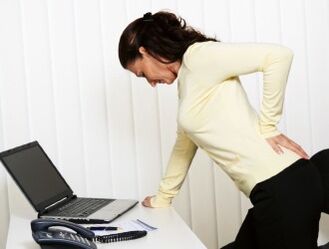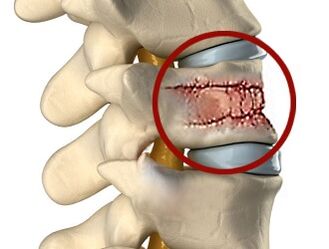
Almost everyone knows back pain., and 15-20% experience this symptom regularly throughout the year.
The problem is not only medical, but also socio-economic in nature, since during the illness, depending on the cause, the patient loses his or her ability to work.
In most cases, it is possible to get rid of the disease in a month, after which the patient can resume normal life.
Despite these results, pain returns in 70% of patients, the treatment is useless because the therapy was wrong or insufficient.
It should be noted that painis a sign of degenerative processes in the spine, which, in turn, are considered signs of pathological conditions.
Classification and type of back pain
types of back pain:
- unspecific(benign) - dorsopathy, "old" osteochondrosis, the cause is most often dysfunctions of the musculoskeletal system, an additional examination is most often useless;
- Specific(dangerous) pain that requires additional diagnostics already at the first visit, which allows to exclude the presence of a vertebral fracture, tuberculosis, a tumor, metastasis, etc. ;
- radicular pain(Radiculopathy) - associated with irritation/compression of the nerve root from a herniated disc.
What diseases of the musculoskeletal system cause pain in the spine in the middle of the back?
Musculoskeletal disorders that cause pain:
- arthrosis- The patient can bend over in pain, tries to straighten his back, takes deep breaths and contributes to increased negative sensations. When compressing the vertebrae, the load on the elastic shock-absorbing pad increases, as a result of which the damaged element becomes thinner.
- Chondrosis, osteochondrosis of the chest region- develops against the background of obesity, physical inactivity, unbalanced diet, disorders of mineral metabolism, in the course of age-related changes, the elasticity and height of the intervertebral discs decrease, their structure changes, pinching of nerve fibers contributes to sudden, severe pain or moderate discomfort, which are aggravated by movements;
- Scoliosis, increased/decreased lordosis, kyphosis- lead to a deterioration in posture and appearance, resulting in pinched nerves in the spine;
- pillar injury;
- neurological causes(radiculitis);
- congenital pathologies- additional / missing vertebrae in the spine lead to painful discomfort;
- myositis- Against the background of inflammation of the skeletal muscles, weaker and increasing pain develops, the discomfort increases with palpation of the back.

Other causes of back pain
Different reasons:
- kidney inflammation- Discomfort is often accompanied by high fever, swelling of the lower extremities, high blood pressure;
- Diseases of the cardiovascular system, vascular pathologies - accompanied by throbbing pain in the back and increased blood pressure;
- chronic stress;
- Digestive system diseases- the pain is localized in the middle or on the left side of the back, after eating the pain intensifies against the background of pancreatitis or diseases of the gastric mucosa;
- psycho-emotional disorder.
Severe diseases of the organs located in the abdominal cavity and under the chest can also react with pain in the spine. It is often very difficult for a patient to determine the nature of the pain. It is recommended to monitor the symptoms and inform the doctor in time.
Treatment of pain in the spine
Before starting treatment, the doctor must make a diagnosis, study the patient's history, listen to complaints, conduct a visual examination and palpation, examine the results of laboratory and diagnostic studies. After that, the necessary drugs are selected, the action of which is aimed at eliminating the problem.
preparations
During an exacerbation, therapy aims to stop the pain signal.
medication:
- Non-steroidal anti-inflammatory drugs- Their action is aimed at stopping mediators of inflammatory processes before they get into the tissues surrounding the spine. It helps get rid of inflammation, fever, swelling, cramps and pain. With severe pain, injectable preparations are prescribed, they are distinguished by their rapid action (15-20 minutes), safety for the gastrointestinal tract, all components are released in the initial dose. To get rid of moderate and mild pain, external preparations or drugs in oral form are prescribed.
- analgesics- are prescribed when the analgesic properties of NSAIDs are insufficient, the drugs affect the transmission of nerve impulses to the brain, which prevents the occurrence of a reaction. It is recommended to carefully carry out the combination of 2 groups, the characteristics of the body, the tolerability of drugs should be taken into account, the choice of dosage is made individually.
- muscle relaxants- Diseases of the spine are often accompanied by muscle spasms, forcing the patient to freeze in one position, all movements lead to severe pain. Injection of muscle relaxants helps to relax the muscular corset, the effect of their administration lasts 12 hours, tablets are used less often, since they begin to act only after the accumulation of the required amount of the substance.
- chondroprotectors- Problems with the spine occur against the background of degenerative processes in the articular and cartilage tissues, in such cases drugs containing chondroitin or glucosamine are prescribed. Substances are the basis for the restoration of tendons, joints, ligaments, etc. These components are not produced in the body, so during a disease the cells should be saturated with the listed substances as much as possible, most often they are prescribed orally. Medicines should be taken in long courses.
As adjunctive therapyVitamin complexes, diuretics, antispasmodics can be prescribed, as well as means for improving trophism and restoring blood circulation, antioxidants, antihistamines and others.
surgery
In the absence of the effect of drug treatment, surgical treatment is indicated, modern techniques can achieve excellent results.With osteochondrosis, injuries and hernias, part of the vertebra or intervertebral disc is removed, plastic surgery is indicated for an aortic aneurysm.
With diseases of the spine, the cause of the development of pain should be established, often the internal organs are the source of unpleasant symptoms. Only a doctor can diagnose a disease and prescribe treatment.
Exercise, exercise therapy, massage
If the patient's condition and the nature of the course of the underlying disease allow, moderate physical activity is required.
Doctors also recommend regular morning exercises, the complex includes the following exercises:
- child pose. Sit on your knees with your head down, stretch your arms forward, stay in this position for 20 seconds, stretch your arms back also for 20 seconds, repeat the exercise twice.
- bow headSit on the floor with your back straight, place your hands behind your head, slowly pull your head forward, tilting it until your chin touches your neck, hold for 10-15 seconds, repeat 8-10Times.
- Spins with a stick. While standing, place the bar horizontally on the back of your neck behind your head, straighten your arms and hold the ends of the bar. Slowly twist to the left with a stick behind your head, hold for 25-30 seconds, repeat in the opposite direction, the number of repetitions is 10-12 times.
- lean your body forward. Standing with feet shoulder-width apart and arms crossed behind the lock, lean body forward, knees bend legs slightly, hold this position for 15-20 seconds, repeat up to 4-5 times.
- Lean body forward, toes touch. Sit on the floor, close your legs, place them in front of you and bend forward to reach your toes with your hands. The exercise should be performed without sudden movements, gradually, slowly, staying in position for a few seconds.
During exacerbations, exercise therapy and other types of physical activity are strictly contraindicated.
massage
Manual massage also has an effect on back pain caused by diseases of the spine.. Techniques allow you to achieve muscle relaxation, during their use soft tissues are heated, which helps to improve blood circulation. Such a massage is recommended for patients with pathologies of the respiratory organs, accompanied by sputum.
Treatment at home or folk remedies
With persistent back pain, it is recommended to turn to folk recipes, before using them you should consult a doctor. Despite the apparent safety, many remedies can be not only useless, but also harmful.
Recommended for pain reliefPrepare an embrocation. To do this, you need to take a mixture of pure alcohol or cologne, a small amount of paprika, valerian root tincture, a bottle of 5% iodine solution, thoroughly rub the affected area with the mixture and wrap it. It is recommended to carry out the procedure at night and leave it warm until the morning. It is very important not to start the disease, to identify the cause of the pathology in time and follow all the recommendations of doctors.
The following steps can help alleviate the condition at home:
- avoid prolonged lying - physically active patients suffer less from pain;
- engage in light exercise - moderate physical activity is best;
- maintain correct posture;
- increase flexibility of the spine;
- wear corsets and belts for the spine;
- apply heat and cold to the affected area;
- quit smoking - nicotine causes spasms of small vessels, which leads to disruption of microcirculation and disruption of oxygen supply to tissues;
- relaxation exercises.
prevention
The patient can prevent the development of back diseases on his own, he must learn how to sleep, sit and stand properly, as well as endure heavy loads with minimal harm to himself. It is recommended to stand and sit with a straight back, the head should not hang forward, one should not bend and bend the body without relying on the hands.
If you must remain on your feet for a long period of time, you should find a place to support your head and limbs. You can lean against a cabinet, wall and other surfaces. Walking in heels for more than 2 hours in a row is excluded, the legs should be periodically rested, for this they should be raised for a couple of minutes.
preventive measures:
- relieve the neck and lower back with special rollers or "bone" pillows, avoid sitting on stools or with a bent back every 15 minutes. You should change posture, stretch and lean back, after every hour of sitting you needtake breaks.
- You have to sleep on hard mattresses without high pillows, you can put orthopedic castors under your head.
- certain rules must be observed when carrying loads, loads of more than 3 kg in women and more than 5 kg in men should not be carried, it is dangerous to lift weights when bending or jerking, bags should be lifted with a straight back, heavy loads should be carried in several steps.
Conclusion
- back pain- a relatively common pathology, in which there is a pain syndrome, you should consult a doctor.
- The causes of pathology are very diverse, the doctor makes a diagnosis based on the history, examinations, complaints of the patient.
- during treatmentdrugs are used(mainly painkillers), it is recommended to carry out massage, exercise therapy.





















